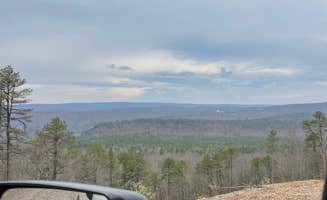Dispersed camping near Artemas, Pennsylvania requires advance planning, especially regarding water supplies. The region sits in the Potomac River watershed with elevations between 500-1,000 feet, creating varied terrain for primitive camping. Winter camping demands extra preparation as temperatures regularly drop below freezing from December through February, with limited road maintenance on access routes.
What to do
Fishing opportunities: Edwards Run Wildlife Management Area offers fishing experiences beyond the main camping area. As camper Frank G. notes, "Fun place to teach the kids the basics of fishing, but the campground area leaves a little to be desired." The stream contains smallmouth bass and panfish with best catches reported in spring.
Hiking exploration: The dispersed camping areas provide access to unmarked trails. At Edwards Run Wildlife Management Area, one visitor recommends exploring further from the roadside sites: "There's a lot by the road that looks like it's where they want you to camp but there are better sites on in. Just gotta hike to em," according to Frank G.
Wildlife observation: The surrounding woods support diverse bird populations and white-tailed deer. During weekday visits to Squirrel Hollow Road Camping, campers report minimal human traffic: "We camped during the week and had nobody else camping on weekdays," making wildlife sightings more common.
What campers like
Spacious camping areas: The dispersed sites offer ample room for multiple tents and vehicles. Jon D. appreciated the generous proportions at Squirrel Hollow Road Camping: "Large campsites and relatively quite. We took two vehicles and found several suitable sites."
Weekday tranquility: Campers frequently mention the peaceful atmosphere during weekdays. Kevin C. observed at Squirrel Hollow Road Camping: "Sites were quiet at night. Some traffic related to logging activity. Looks like a popular weekend camp spot for locals."
Basic roadside access: The camping locations offer straightforward vehicle access to several sites. Jim M. found Edwards Run Wildlife Management Area provided suitable conditions: "The site was level and grassy."
What you should know
Fee structure uncertainty: Campers report inconsistent information about camping fees. At Edwards Run Wildlife Management Area, Jim M. noted: "As I pulled in there was a kiosk with a sign that said $10 camping fee but no info on how or where to pay. I tried to look at the WVDNR website but couldn't find it there either."
Self-sufficient camping required: Pack all necessary supplies when visiting these dispersed camping areas. Kevin C. explains the expectations at Squirrel Hollow: "True boondocking, haul it in, pack it out. Evidence of a cat hole in the site we picked."
Variable site conditions: The quality of camping spots differs considerably between roadside and interior locations. At Edwards Run Wildlife Management Area, Frank G. recommends: "There's a lot by the road that looks like it's where they want you to camp but there are better sites on in."
Tips for camping with families
Beginner fishing location: The fishing areas provide low-pressure environments for children learning to fish. Frank G. shares that Edwards Run Wildlife Management Area is a "Fun place to teach the kids the basics of fishing."
Multiple vehicle considerations: Groups with several vehicles can find accommodating spaces. Jon D. reports from Squirrel Hollow: "We took two vehicles and found several suitable sites. Traffic was light with one pickup overnight and a small convoy of motorcycles the next morning."
Plan for no facilities: Families need to prepare for camping without amenities. While Edwards Run Wildlife Management Area has vault toilets, Squirrel Hollow requires complete self-sufficiency with no restroom facilities available.
Tips from RVers
Small trailer accessibility: The access roads can accommodate modest-sized trailers with proper planning. Kevin C. found that at Squirrel Hollow Road Camping: "Sites are located less than a mile from the paved highway. We found 5 spots just off the road. All were easily accessible by cat or with a small teardrop trailer."
Limited turn-around space: Larger RVs may struggle with the confined road network. The narrow access roads have few designated turn-around areas, requiring advance scouting for suitable sites.
Roadside options preferred: For those with trailers, the roadside camping spots offer the most practical setup. The interior sites require hiking access not suitable for RV camping.


